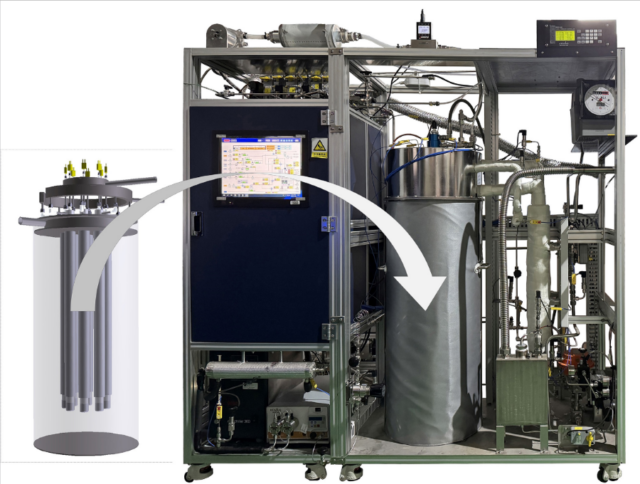KIER unveils improved ammonia cracking system
By Geofrey Njovu on May 31, 2024
For several years, the Korea Institute of Energy Research (KIER) has operated an ammonia cracking test facility, which produces about 43 kg per day of hydrogen. The process uses a Ruthenium catalyst at around 600°C for ammonia cracking followed by Temperature Swing Adsorption (TSA) and Pressure Swing Adsorption (PSA) to separate ammonia and nitrogen respectively from the output gas.
As in conventional ammonia cracking, this version of KIER’s process uses a combination of recycled heat from the residual gas mixture, supplemented with fossil fuels such as natural gas (LNG) or liquefied petroleum gas (LPG). The system was first demonstrated in 2021.
Towards fossil-free ammonia cracking

Click to learn more. KIER’s new ammonia cracking system will be powered by ammonia and will feature a single-step PSA process for hydrogen purification. Source: KIER
Three years later, in March 2024, the KIER announced the successful testing of an improved version of its process. The demonstration featured a 10 kg per-day high purity hydrogen production system, with two notable improvements over the old system.
First, using the same catalyst at the same temperature, the new system will use ammonia as a source of heat for the reaction, eliminating the use of LNG or LPG and reducing the process’ carbon footprint. Second, the new system will only use pressure swing absorption (PSA) for ammonia and nitrogen separation, channelling the residual nitrogen and hydrogen towards the heating element. This eliminates the TSA, making the new design simpler and thus less capital intensive.
With nitrogen and ammonia impurity concentrations of 300 ppm and 0.1 ppm respectively, the hydrogen produced from KIER’s system meets the ISO 14687 standard1, making it suitable for use in hydrogen-fueled electric vehicles and stationary applications.
Partnering with Doosan Fuel Cell Power, the KIER team tested a 1 kW PEM fuel cell system for buildings using hydrogen extracted from ammonia, successfully generating building electricity and providing stable operations. The research was supported by the Korea Southern Power Co., Ltd. (KOSPO). The research team will now seek to increase the capacity of the new system.
To learn more about the original test system, you can access a copy of KIER’s presentation at the 2022 Ammonia Energy Conference in Australia here.
The newly developed technology holds great significance as it allows for carbon-free hydrogen production using ammonia, filling a previous gap in this area. There is an expectation that it will find practicality in diverse areas that use clean hydrogen. The combining of ammonia and fuel cells presents a viable option for powering eco-ships. And as we scale up, we can also make a significant impact in the clean hydrogen power sector.
Dr. Jung Unho, lead researcher, in his organisation’s official press release, 11 March 2024
1. ISO 14687: international standard specifying minimum quality characteristics for hydrogen fuel distributed for use in vehicles and stationary applications.